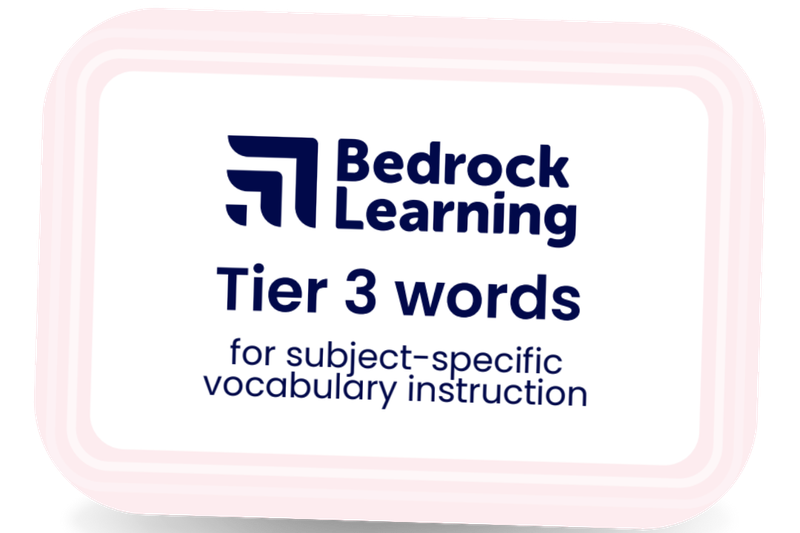What is Tier 3 vocabulary?
Knowledge of a broad vocabulary is crucial for learners to succeed, both in the classroom and beyond the school gates. English is the language of all learning, not just literacy - but not all vocabulary knowledge is the same or has the same purpose.
In order for teachers to tackle the subject of “vocabulary instruction”, it’s more efficient to break vocabulary down into its purpose. This way, vocabulary can be taught consistently across the curriculum. One way of doing this, supported by research by Beck, McKeown and Kucan, is by separating vocabulary into three tiers.
Beck, McKeown and Kucan (2002) came up with an efficient way of breaking down vocabulary, and vocabulary instruction, into smaller, more manageable parts. In their book Bringing Words to Life, they segmented the vocabulary we use into three tiers - Tier 1, Tier 2 and Tier 3.
Tier 1 vocabulary consists of the language we use in day-to-day conversation. These words are the simplest and are used casually. Tier 1 vocabulary includes words such as “put”, “walk” and “jump” - essentially, Tier 1 vocabulary includes the words that are used in conversation and are learned incidentally through casual dialogue with others. Understanding Tier 1 language gives learners the ability to engage in everyday conversation and communicate with others, but Tier 1 vocabulary knowledge alone is not sufficient for learners to access the academic texts of the school curriculum.
Tier 2 vocabulary is made up of more challenging, ambitious, often academic words. While not usually used in everyday conversation, these words come up regularly in academic texts and understanding them is crucial to learners’ development. Unlike Tier 1 vocabulary, these words are not easy to learn incidentally due to the fact that they only appear in challenging academic texts; learners who are avid readers and find enjoyment in books may encounter these words, but learners who are already struggling with their reading comprehension are further restricted from developing their vocabulary; the lack of the vocabulary knowledge needed to access challenging texts forms a self-perpetuating cycle, where learners are unable to read new texts and, due to this, unable to develop their Tier 2 vocabulary.
Read more about Tier 2 vocabulary and how you can teach it explicitly in our full blog.
However, Tier 1 and Tier 2 vocabulary share a common feature: their high frequency. While Tier 2 vocabulary isn’t often used in casual conversation, it comes up frequently in written text, making it high-frequency vocabulary. Tier 3 vocabulary, on the other hand, is low frequency and only comes up in specific disciplines and contexts. For example, a word like “osmosis” rarely appears in fiction texts or dialogue, but understanding this word is crucial for developing a full understanding of molecules and the function of cells. Explicitly teaching Tier 3 vocabulary is crucial for unlocking learners’ potential in all subjects across the curriculum; every subject has its own discipline-specific vocabulary, and understanding how these words fit into the context of their disciplines is crucial for allowing learners to think, speak and write like experts in every subject.
Read more about disciplinary literacy.
In order to make the most of the changing world around them, learners need a firm understanding of all three tiers of vocabulary. Together, these tiers give learners the skills to communicate with one another, write coherent written responses and demonstrate mastery in subjects across the curriculum. Tier 3 vocabulary is just one part of enriching learners with the literacy skills they need to thrive, - and, importantly, it is the role of every teacher across the school curriculum to ensure Tier 3 vocabulary is taught explicitly.
To support this, we have collated some of the most important Tier 3 terms from 8 subjects. Tier 3 vocabulary is not just the responsibility of English teachers - teachers of every discipline have a responsibility to teach this vocabulary.
Why is Tier 3 vocabulary important?
The correct use of Tier 3 vocabulary is one of the signs examiners use to evaluate a learner’s mastery of a concept. If a learner has a full understanding of a particular concept in Biology but is unable to use the correct terminology, they are held back from achieving their full potential. As well as this, a lack of understanding of the scientific terminology keeps them from achieving mastery of new topics.
Many subject leaders already have aspects of Tier 3 vocabulary instruction in their subjects, such as putting new keywords and their definitions on the board and encouraging learners to copy them into their books. This sets Tier 3 vocabulary apart from Tier 1 and 2, as it is not assumed that any learners in the class will have come across such niche, low-frequency words incidentally. This means that every learner is explicitly taught in the same way. However, simply copying down the definition does not give learners a rich understanding of new terminology, and it does not mean learners have the ability to use the word in their own writing.
Explicitly teaching Tier 3 vocabulary in a way that is clear and consistent ensures learners are able to comprehend new terminology and apply it to knowledge they already have. As well as this, they are able to use subject-specific vocabulary in their own writing, allowing them to communicate like experts in any given subject. This boosts their attainment across the curriculum, as well as helping to unlock their potential beyond the school gates.
To ensure that subject-specific Tier 3 vocabulary is mastered, it is the responsibility of every teacher in every subject to make teaching vocabulary a priority. This goes beyond simply teaching learners definitions of complex terminology - this means investing time and energy into creating a consistent, well-structured vocabulary curriculum in every subject.
Creating a whole-school literacy strategy like this can be incredibly time-consuming, especially when teachers are juggling teaching Tier 3 vocabulary with teaching the content learners need for their end of year exams. That is why edtech resources such as Bedrock Mapper can help teachers in every subject prioritise Tier 3 vocabulary and reap the rewards of improving learners’ literacy.

Subject specific vocabulary instruction made easy
Access every subject’s keyword list in one place. Every single word is taught using a research-based learning sequence and then automatically memory-checked and retaught
Tier 3 word list
While disciplinary literacy is becoming increasingly prevalent in many schools’ curricula, there are still some teachers where buy-in for explicit Tier 3 vocabulary instruction is a struggle. Some teachers still see literacy improvement as the responsibility of the English department, not the whole school. As well as this, teachers from content-heavy subjects may struggle to find time to come up with a deep, rich vocabulary strategy for their subject from scratch.
That’s why we have collated some of the most important Tier 3 words from eight common GCSE subjects. Creating a vocabulary curriculum centred around these words may help teachers find time to coordinate a Tier 3 vocabulary strategy.
In addition to this, these words can be found already mapped and available on Bedrock Mapper, ready to be taught to your learners as homework or using edtech in class.

Transform Tier 3 vocabulary with Bedrock Mapper
Create a broad, deep, curriculum that refines learners’ subject knowledge and improves educational outcomes across all subjects. Start your free trial today.
How Bedrock uses Tier 3 vocabulary
Bedrock Learning created the Bedrock Mapper curriculum to help teachers create a consistent Tier 3 vocabulary curriculum.
One of the primary reasons why many teachers didn’t fully implement explicit Tier 3 vocabulary instruction in their lessons was due to time constraints. It goes without saying that time is already limited when teachers are planning the content learners need for their exams, let alone fitting in a rich, consistent vocabulary curriculum.
To tackle this, Bedrock Mapper allows teachers to access ready-made, Bedrock-created content for subject-specific vocabulary in their discipline. At a click of a button, teachers can add a bespoke vocabulary curriculum to their learners’ lesson plan. Teachers have the freedom to change definitions, add their own custom images, even craft a fully individualised vocabulary curriculum - or, alternatively, teachers can access an entire Tier 3 vocabulary curriculum for their subject and topic in an instant.
As well as this, teachers of all subject areas can access the Bedrock Mapper dashboard, allowing your faculty to coordinate their vocabulary instruction approach quickly and effortlessly.
When combined with Bedrock Learning’s vocabulary and grammar curricula, Bedrock provides teachers and learners with a time-saving literacy improvement tool that unlocks learners’ potential in every subject.



